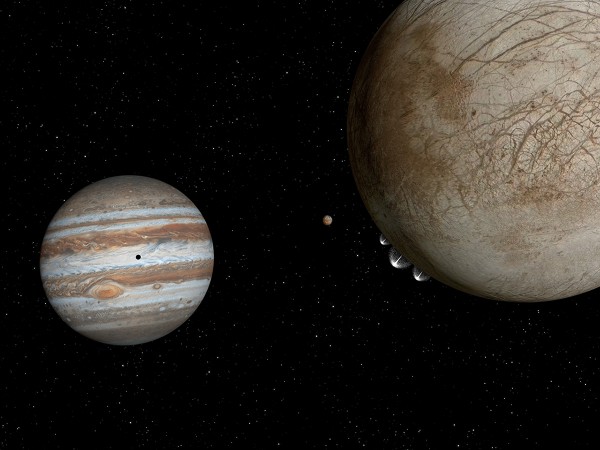By Ana Verayo, | September 27, 2016

This is an artist's concept of the moon Europa, at right, with water-ice plumes erupting from its lower left limb at the 7 o'clock position
NASA's Hubble Space Telescope has just revealed images of jets of water and ice, emitted by Jupiter's moon Europa. On three separate events, scientists have confirmed the presence of water and ice on the Europa.
Like Us on Facebook
These plumes emitted around two million pounds of ice and water, which have been traced to a salty global ocean under Europa's icy crust. This hidden ocean, however, has not been observed by mission scientists. Some researchers believe that this ocean can potentially harbor life.
According to the author of the study, Space Telescope Science Institute's William Sparks, this is an exciting finding as such plumes can allow us to search for signs of life under the oceans of Europa without having to drill into miles of ice.
Past studies by Hubble has already revealed evidence of Europa's plumes. However, these findings were based on chemical signatures of water upon detection. In this new study, these jets of water, which are similar to geysers on Earth, are observed around Jupiter's large bright disk.
Europa's ocean is covered by an icy shell, and its seabed is suggested to be composed of rocky material, containing twice as much water than the Earth's oceans combined. This hidden salty ocean is believed to shoot up water via cracks and crevices of ice that is estimated to be more than 10 miles thick.
According to lead program scientist, Curt Niebur of NASA's New Frontiers program, the important thing is that these plumes were observed using an entirely different method. This provided direct observational evidence that this is not just a fluke but something physical.
NASA hopes to launch a Europa mission soon with a spacecraft that can orbit and conduct multiple flybys. However, visiting Jupiter's moon can take a decade, according to the space agency.
This new study is published in the Astrophysical Journal.
-
Use of Coronavirus Pandemic Drones Raises Privacy Concerns: Drones Spread Fear, Local Officials Say

-
Coronavirus Hampers The Delivery Of Lockheed Martin F-35 Stealth Fighters For 2020

-
Instagram Speeds Up Plans to Add Account Memorialization Feature Due to COVID-19 Deaths

-
NASA: Perseverance Plans to Bring 'Mars Rock' to Earth in 2031

-
600 Dead And 3,000 In The Hospital as Iranians Believed Drinking High-Concentrations of Alcohol Can Cure The Coronavirus

-
600 Dead And 3,000 In The Hospital as Iranians Believed Drinking High-Concentrations of Alcohol Can Cure The Coronavirus

-
COVID-19: Doctors, Nurses Use Virtual Reality to Learn New Skills in Treating Coronavirus Patients







